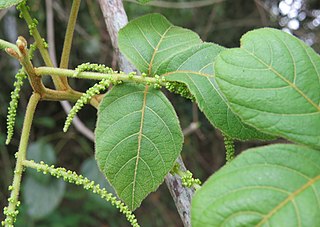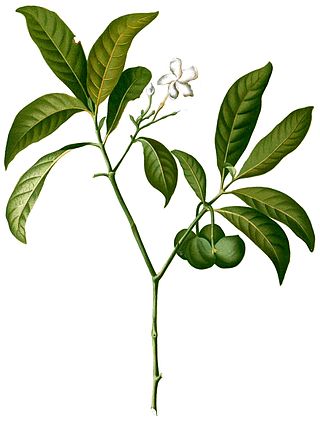
Cauliflory is a botanical term referring to plants that flower and fruit from their main stems or woody trunks, rather than from new growth and shoots. It is rare in temperate regions but common in tropical forests.

Selenicereus, sometimes known as moonlight cactus, is a genus of epiphytic, lithophytic, and terrestrial cacti, found in Mexico, Central America, the Caribbean and northern South America. The term night-blooming cereus is also sometimes used, but this is also used for many night-blooming cacti, including Epiphyllum and Peniocereus. In 2017, the genus Hylocereus was brought into synonymy with Selenicereus. A number of species of Selenicereus produce fruit that is eaten. The fruit, known as pitaya or pitahaya in Spanish or as dragon fruit, may be collected from the wild or the plants may be cultivated.

Archontophoenix alexandrae, commonly known as Alexandra palm, king palm, northern Bangalow palm, or feather palm, is a palm endemic to Queensland, Australia. It was named in honour of Princess Alexandra of Denmark, but is often erroneously referred to by the misnomer Alexander palm.

Leea is a genus of plants in the family Vitaceae, subfamily Leeoideae, that are native to parts of central Africa, tropical Asia, Australia and Melanesia. It was previously placed in its own family, Leeaceae, based on morphological differences between it and other Vitaceae genera. These differences include ovule number per locule, carpel number, and the absence or presence of a staminoidal tube and floral disc. Pollen structure has also been examined for taxonomic demarcation, though studies have concluded that the pollen of Leeaceae and Vitaceae suggests the families should remain separate while other studies conclude that Leea should be included in Vitaceae.

Heritiera littoralis, commonly known as the looking-glass mangrove or tulip mangrove, is a mangrove tree in the family Malvaceae native to coastal areas of eastern Africa, Asia, Melanesia and northern Australia. The common name refers to the silvery appearance of the underside of the leaves, resembling a mirror to some degree. The strong timber has uses in marine applications and elsewhere.

Kew Gardens is a botanic garden in southwest London that houses the "largest and most diverse botanical and mycological collections in the world". Founded in 1840, from the exotic garden at Kew Park, its living collections include some of the 27,000 taxa curated by Royal Botanic Gardens, Kew, while the herbarium, one of the largest in the world, has over 8.5 million preserved plant and fungal specimens. The library contains more than 750,000 volumes, and the illustrations collection contains more than 175,000 prints and drawings of plants. It is one of London's top tourist attractions and is a World Heritage Site.

Allophylus cobbe, commonly known as titberry or Indian allophylus, is a pantropical, shrub in the family Sapindaceae with many uses in traditional medicine. It has a highly variable morphology throughout its range and may prove to be more than one species.

Leea indica is a large shrub in the family Vitaceae which may grow up to 5 m (16 ft) tall. It is common in undergrowth of secondary and disturbed evergreen forests in Indomalaya, Indochina, and throughout in the Western Ghats of India. Plants growing in Malesia, New Guinea, Australia and southwestern Pacific islands were previously identified as this species but are now considered to be the separate species Leea nova-guineensis.
Motandra is a genus of plant in the family Apocynaceae native to tropical Africa. As of August 2013 the World Checklist of Selected Plant Families recognises 3 species:
- Motandra guineensis(Thonn.) A.DC. - widespread from Liberia to Sudan and south to Angola
- Motandra lujaeDe Wild. & T.Durand - Gabon, Congo, Cabinda, Equatorial Guinea, Zaire
- Motandra poecilophyllaWernham - Gabon, Congo, Equatorial Guinea, Cameroon
- Motandra erlangeriK.Schum = Oncinotis tenuilobaStapf
- Motandra glabrataBaill. = Oncinotis glabrata(Baill.) Stapf ex Hiern
- Motandra viridifloraK.Schum. = Baissea viridiflora(K.Schum.) de Kruif
- Motandra welwitschianaBaill. = Oncinotis hirtaOliv.

Voacanga is a genus of plants in the family Apocynaceae found in Africa, Southeast Asia, New Guinea, and Australia. As of August 2013 the World Checklist of Selected Plant Families recognises 13 species:
- Voacanga africanaStapf ex Scott-Elliot - tropical W + C + E + S Africa
- Voacanga bracteataStapf - tropical W + C Africa
- Voacanga caudifloraStapf - tropical W Africa
- Voacanga chalotianaPierre ex Stapf - tropical C Africa
- Voacanga foetida(Blume) Rolfe -Java, Borneo, Sumatra, Philippines
- Voacanga globosa(Blanco) Merr. - Philippines
- Voacanga gracilipes(Miq.) Markgr. - Maluku
- Voacanga grandifolia(Miq.) Rolfe - Indonesia, Philippines, New Guinea, Queensland
- Voacanga havilandiiRidl. - Sarawak
- Voacanga megacarpaMerr. - Philippines
- Voacanga pachycerasLeeuwenb. - Zaïre
- Voacanga psilocalyxPierre ex Stapf - Nigeria, Cameroon, Gabon, Republic of Congo
- Voacanga thouarsiiRoem. & Schult. Madagascar; widespread from Cape Province to Sudan + Senegal
- Voacanga dichotoma = Tabernaemontana pachysiphon
- Voacanga plumeriifolia = Tabernaemontana macrocarpa

Crotalaria verrucosa, the blue rattlepod, is a species of flowering plant in the legume family, Fabaceae. This shrub belongs to the subfamily Faboideae. The herb can be found in tropical and subtropical areas from in Bangladesh to Sri Lanka in South Asia, Southeast Asia, Australasia and Central America.

Syzygium forte, commonly known as flaky-barked satinash, white apple or brown satinash, is a tree in the family Myrtaceae native to New Guinea and northern Australia.
Plants of the World Online (POWO) is an online database published by the Royal Botanic Gardens, Kew. It was launched in March 2017 with the ultimate aim being "to enable users to access information on all the world's known seed-bearing plants by 2020". The initial focus was on tropical African Floras, particularly Flora Zambesiaca, Flora of West Tropical Africa and Flora of Tropical East Africa.
Excoecaria guineensis is a species of flowering plant in the family Euphorbiaceae. It was originally described as Stillingia guineensisBenth. in 1849. It is native to western and central tropical Africa.
Adenia cissampeloides is a species of flowering plant in the passionflower family, Passifloraceae. It is native to tropical Africa.
Garcinia binucao is a species of flowering plant in the Clusiaceae family. It is commonly known as binukaw or batuan, is a species of Garcinia endemic to the Philippines. It is not cultivated, though its edible fruits are harvested from the wild for use as a souring agent in some Filipino dishes.
Syzygium apodophyllum is a tree in the Myrtaceae family endemic to north Queensland. The fruit is edible. It is a host for the exotic plant-pathogen fungus Austropuccinia psidii, which is causing a lot of damage to vegetation communities and economic plants.
Lagenaria breviflora is a species of flowering plant. It is a climbing vine that is found across Central Africa, East Africa, and West Africa. It has large, 7 to 20 cm ovate-triangular leaves with hairy undersides and partly-dense hairs on the leaf petioles. It grows vine branches up to 6 meters long. It forms ~9x7 cm oblong, green fruits with whitish spots across the surface. The fruits are similar to those of other members of the Lagenaria genus.

Uvariopsis guineensis is a species of plant in the Annonaceae family. It is native to Guinea, Ivory Coast, Liberia, and Sierra Leone. Ronald William John Keay, the botanist who first formally described the species, named it after Guinea, then called French Guinea, where the specimens he examined were collected near a locality he identifies as Fassakoidou.

Leea nova-guineensis, commonly known as bandicoot berry, is a plant in the family Vitaceae native to parts of Malesia and Oceania.












